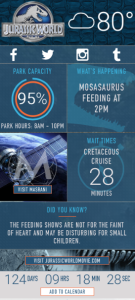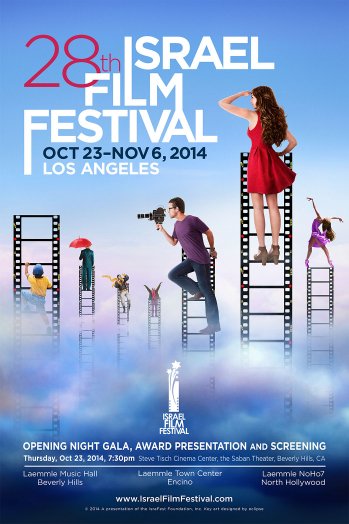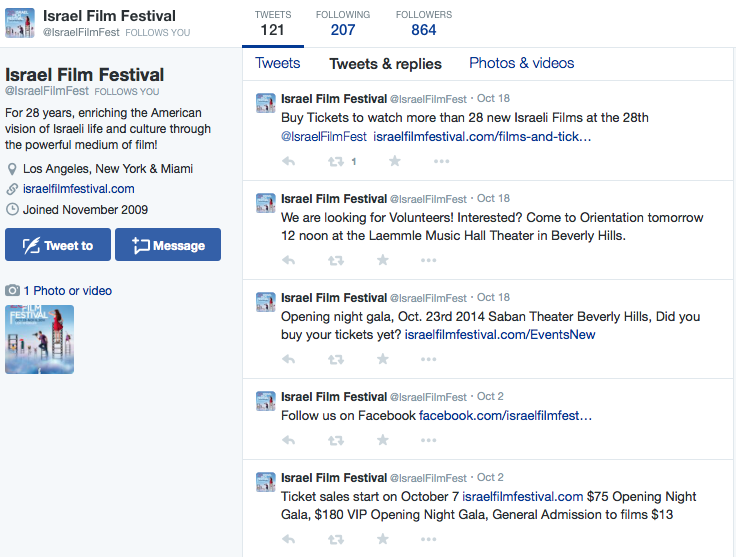Unsolicited Advice & Case Studies

Jurassic World: The Transmedia Story Begins
1If you watched the Super Bowl, you probably already saw the ad for Jurassic World, the next sure-to-be-a-blockbuster summer movie in a franchise that continues to ask the question, “if we rebuilt the park AGAIN…would it still be a disaster?” and adds the question, “if we created an even deadlier dinosaur than a T-Rex…would that create a safe theme park environment?” While I’m guessing the answer are “yes” and “no,” respectively, from the minute I hear the John Williams score, I’m on board.
But if you’re on the electrified paddock fence about contributing your movie ticket’s cost to creating a blockbuster, Jurassic World wants you: you might not be interested in another dino-disaster flick, but could they interest you in a relaxing trip to the Hilton Isla Nublar, to enjoy the family attractions of their theme park?
Of course, Isla Nublar isn’t a real place. But that hasn’t stopped Jurassic World from launching the story of the film – which isn’t out for another 4 months – through an impressively-detailed website that mimics the life and offerings of a real-life theme park. The site features restaurant menus at the park’s dining establishments, educational materials about the dinosaurs that visitors will encounter, and “live-cam” footage from the park. If you’re really looking for it can you find the link, in tiny print, that says “visit jurassicworldmovie.com.” And if you try to “book” one of their packages – which come in Standard, Family, Adrenaline, Romance and others, each built-out and better-programmed than some conferences I’ve been to – you will get re-routed to Fandango. Otherwise, you can go about your business fantasizing about your luxurious fake-cation.
Jurassic World is creating its narrative’s world through transmedia – creating content across multiple media, in support of a story that will exist or already does exist somewhere else (at least that’s my layperson’s explanation; see here for something “more official“).
Transmedia extends the story and enables more personalized access to the narrative than a one-directional film aimed at an audience in a darkened theater could, and expands the reach of that story using different tools in the storytelling toolkit. Whether it’s webisodes that tell you more about minor characters or deepen historical backstory for a TV show or a peek inside the diary or blog of a character who’s always depicted as scribbling in a notebook, transmedia is a reward for fans who want to know more and a tool to deepen their relationship to the show. It’s like backchannel chatter among those in the know. Sharing information can be a powerful thing that builds trust and investment, creating a proud cohort of evangelists who can represent your brand even when you’re on your lunch break.
It’s become trendy to talk about “storytelling” when it comes to branding. But the word “story” itself doesn’t mean what it classically used to. Now there’s the all-access story, the story-behind-the-story, the context for the story, the story-after-the-story.
The JurassicWorld.com website may still not convince you to see Jurassic World, the movie. But if it convinces you of one thing, let it persuade you to accept that people are learning to expect a narrative that is dynamic, expanding beyond its initially perceived limits. And the most successful brands and organizations will spend the time, creativity and money to build out the universe around the main story in a way that supports their core message, whether it’s donations or dinosaurs.

Hacking Your Own Identity
0 We’re all guilty of it, from time to time, trading in rumors, snark and jokes at the expense of others, especially when we think no one’s watching. The fact is, like in Terry Benedict’s casino in Ocean’s 11, on the internet, there’s always someone watching.
We’re all guilty of it, from time to time, trading in rumors, snark and jokes at the expense of others, especially when we think no one’s watching. The fact is, like in Terry Benedict’s casino in Ocean’s 11, on the internet, there’s always someone watching.
Recently, Sony’s Scott Rudin and Amy Pascal found this out firsthand during the massive hack of Sony Pictures, as several of the communications they thought would remain between them went public in a major way, along with thousands of other leaked internal documents. Snarking about colleagues is nothing new; we’ve all been on this e-mail chains with people trying to out joke each other as they poke and prod at the people in power. But in Rudin & Pascal’s case, one of those people in power was the President, and the content was “racially tinged,” as the New York Times put it.
Post-hack, Rudin and Pascal both released statements. Rudin’s read, in part:
“[…] private emails between friends and colleagues written in haste and without much thought or sensitivity, even when the content of them is meant to be in jest, can result in offense where none was intended.”
In addition to the discussion on what constitutes professional behavior in the entertainment industry, and identifying the considerable role that gossip plays, the hack also launched a conversation among journalists about how to handle information resulting from the hack. Several journalists were concerned that the “information” had actually less of a “the public has a right to know” caliber than a salacious “yep, we knew that people in Hollywood talked behind each others’ backs” quality to them – that distinction was the difference for many between feeling obliged to use the information and feeling that using the information would be both gossip and a validation for the hackers’ methods.
There are certain things that are out of our control, especially in this wild world of internet transparency, with endless space in the cloud – wherever that is – to record our most inane or insane moments. But the space between the character we display in our public moments and the way we conduct ourselves online seems to be widening. While we may not be inclined to cease joking about people in power, be they presidents or supervisors or Angelina Jolie or Kevin Hart or parents or siblings, those of us who care about being consistent in our character might want to take an extra look at that email before it’s sent, or that blog post before it’s published, or that Tweet before it’s tweeted.
Are we the people we are in our face-to-face interactions, or are we the people we are in our private communications, when we think no one else is watching? And when we pause before posting, we should think for an extra minute or two (or 60) – is this a statement we want to be associated with our name, not just in a private email but in public?
In other words, let’s hack our own identities – both online and off – to more fully understand how our private correspondence connects to who we are as we walk through the world, both professionally and personally.

Social Media Case Study: Unsolicited Advice for the Israel Film Festival
0When I lived in New York, one of the focal points of my entertainment year was the Israel Film Festival. My friends and I, pre-Hulu, pre-Netflix, pre-much-of-anything-other-than-mainstream-modes-of-entertainment, eagerly anticipated the annual display of Jewiness-on-film meets Zionism, the Jewish geography and Hebrew immersion experience that was the Festival. We all knew when the Festival was happening, where it was happening and what was playing. I remember that most of the shows were sold out well in advance, because of the collective New York Israel-loving-and-missing community, many of us in our twenties. We planned outings, doing dinner or drinks first at a local bar or on several occasions, sinking into New York cliche with frozen hot chocolate at Serendipity, which had the convenience of being nearby the theater.
And all of that was before social media.
Since I moved to LA, I’ve either been out of town for the IFF (my fault, but usually because I’m in Israel), or have been in town but have been unaware that it’s happening. This doesn’t seem possible, as I spend most of the day online and connected to the Jewish world. I follow the IFF on Twitter, and subscribe to their FB page, as well as email blasts from the Jewish Journal and the IAC. This year, one of my friends posted about it on Facebook. But if not for that, I might have woken up someday next week and learned that I had missed it yet again.
Theoretically, in this age of hyper-connectivity, I should have been overwhelmed with communications regarding the IFF, both in advance and once it was underway. So why wasn’t I? Part of the problem is that communications are overwhelming generally – since I rarely pick up a copy of the Jewish Journal and read only selected articles online, it’s not the mainstream media that’s the problem as much as it is the evolving way we consume that information. And it might be, in part, because their social media presence is so minimal and they are failing to mobilize the audience (and their sponsors) as brand ambassadors and PR agents.
Because Facebook is an inexplicable mystery when it comes to assessing the potential for organic reach without advertising (and because they should be advertising to LA Jews and don’t seem to be), let’s take a look at the Twitter account for @israelfilmfest.
Their account, since November 2009, has tweeted 121 times. They have under 1000 followers. Most of the “people” they’re “following” on Twitter aren’t people at all: they’re other Film Festivals (who are not likely to share, retweet or publicize the IFF’s efforts) and organizations (some partners, who should be sharing/retweeting/publicizing, but don’t seem to be). And – most disturbingly – only have tweeted 5 times in the month of October, precisely when tweets should have been, if not fast and furious, then laden with information, tempting offers and tidbits about the festival’s films. The website links to a few pieces about the Festival, but imagine the reach of those pieces expanded by social media…
This advice is unsolicited. But because I love the Festival, I’m sharing some tips about how to do it better next year (or at the other two outings of the festival, upcoming in Miami and New York….but don’t ask me when those are or were, since that info doesn’t seem to be on the IFF website).
1. Use your assets in promoting the festival. The filmmakers. The content of their work. Their actors. People in LA who are Israeli or support Israeli culture. Local kosher/Israeli establishments. Festival partners. Organizations who aren’t financial sponsors, but could be content partners. And the organizers should have shot wide in terms of the angles that could be explored for coverage. For instance:
- People who are in the know about Israeli music get giddy at the fact that Meir Fenigstein founded and runs the Festival, it’s like being in the same room with one of the Beatles. Why isn’t there an article about Poogy/Kaveret, or about the music of Israeli films?
- Fenigstein told a story at the screening of “The Go-Go Boys” about Menahem Golan’s role in suggesting and sponsoring the first IFF. Why wasn’t that a first-person piece (or an interview) in the Jewish Journal, Variety, THR, The Writer’s Guild, the Academy of Motion Picture Arts & Sciences, or EW?
- Cannon Films, the Golan/Globus production company that became huge in the 80s and is the focus of The Go-Go Boys,” producing Death Wish, Bloodsport & Breakin’, must have inspired dozens of filmmakers (in addition to Eli Roth, who is featured in the film). Maybe pitch Quentin Tarantino on writing something about his favorite Cannon Films outing, or invite Eli Roth to introduce the film at the Festival? (They may have, but these are the types of ideas I mea when I say “shooting wide…” in regard to PR.)
2. Enhance your social media presence. Ideally, hire someone (or designate a web-savvy volunteer) to coordinate a multi prong social media approach, including (at minimum) Facebook, Twitter & Instagram. But I know sometimes Jewish nonprofits can’t allocate those funds, in which case less ideal but still a plan, hire a consultant to create a plan for you to implement before during and after the festival. And that’s #3…
3. Create a content plan, including a commitment to Tweeting regularly leading up to and during the festival. In addition to varying the types of content posted (trivia, Q&A about the festival or its films, short video clips, shoutouts to filmmakers, links to purchase etc), this content plan should also clearly identify the goals of each week’s social media outreach. Which week will be primarily about promotion and identifying potential partners/sponsors? Which week will be about getting people in the seats? Which week will be about celebrating the people who come and the energy on-site? (That there are NO PHOTOS on the Photos tab on the website as of November 2 – a week into the festival with almost a week to go – is not a good sign.)
Keeping Twitter current and active on its own (or even using magical Facbeook advertising) isn’t necessarily going to sell out the festival. But today, there are so many (free or mostly free) tools that are available – why not use them?
(If the folks at the IFF want help with this next year, they can feel free to be in touch. I’ll give them a decent rate, I promise. :))
Want more posts like this one? Consider joining my new mailing list. No spam, no overwhelming emails, just the occasional conversation starter/act of self-promotion. 🙂 Sign up here…


